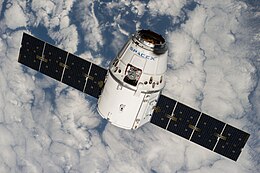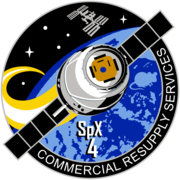SpaceX CRS-4

SpaceX CRS-4 Dragon approaching ISS on 23 September 2014
|
|
| Mission type | ISS resupply |
|---|---|
| Operator | NASA |
| COSPAR ID | 2014-056A |
| SATCAT no. | 40210 |
| Mission duration | Planned: 4 weeks Elapsed: 34 days |
| Spacecraft properties | |
| Spacecraft type | Dragon |
| Manufacturer | SpaceX |
| Start of mission | |
| Launch date | 21 September 2014, 05:52:03 UTC |
| Rocket | Falcon 9 v1.1 |
| Launch site | Cape Canaveral SLC-40 |
| Contractor | SpaceX |
| End of mission | |
| Disposal | Recovered |
| Landing date | 25 October 2014, 19:38 UTC |
| Orbital parameters | |
| Reference system | Geocentric |
| Regime | Low Earth |
| Inclination | 51.6 degrees |
| Epoch | Planned |
| Berthing at ISS | |
| Berthing port | Harmony nadir |
| RMS capture | 23 September 2014, 10:52 UTC |
| Berthing date | 23 September 2014, 13:21 UTC |
| Unberthing date | 25 October 2014, 12:02 UTC |
| RMS release | 25 October 2014, 13:57 UTC |
| Time berthed | 31 days, 22 hours, 41 minutes |
| Cargo | |
| Mass | 2,216 kg (4,885 lb) |
| Pressurised | 1,627 kg (3,587 lb) |
| Unpressurised | 589 kg (1,299 lb) |
|
|
|
SpaceX CRS-4, also known as SpX-4, was a cargo resupply mission to the International Space Station, contracted to NASA, which was launched on 21 September 2014 and arrived at the space station on 23 September 2014. It was the sixth flight for SpaceX's uncrewed Dragon cargo spacecraft, and the fourth SpaceX operational mission contracted to NASA under a Commercial Resupply Services contract. The mission brought equipment and supplies to the space station, including the first 3D printer to be tested in space, a device to measure wind speed on Earth, and small satellites to be launched from the station. It also brought 20 mice for long-term research aboard the ISS.
After a scrub due to poor weather conditions on 20 September 2014, the launch occurred on Sunday, 21 September 2014 at 1:52 a.m. EDT (0552 GMT) from Cape Canaveral Air Force Station in Florida.
NASA contracted for the CRS-4 mission and therefore determined the primary payload, date/time of launch, and target orbital parameters. The payload consisted of 4,885 pounds of cargo, including 1,380 pounds of crew supplies. The cargo included the ISS-RapidScat, a Scatterometer designed to support weather forecasting by bouncing microwaves off the ocean’s surface to measure wind speed, which was launched as an external payload to be attached on the end of the station's Columbus laboratory. CRS-4 also includes the Space Station Integrated Kinetic Launcher for Orbital Payload Systems (SSIKLOPS), which will provide still another means to release other small satellites from the ISS. In addition, CRS-4 carried a new permanent life science research facility to the station: the Bone Densitometer (BD) payload, developed by Techshot, which provides a bone density scanning capability on ISS for utilization by NASA and the Center for the Advancement of Science in Space (CASIS). The system measures bone mineral density (and lean and fat tissue) in mice using Dual-Energy X-ray Absorptiometry (DEXA).
...
Wikipedia

